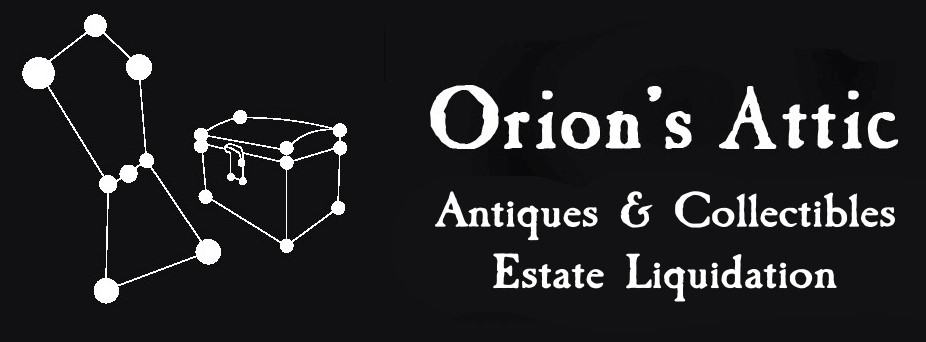A case study on how to liquidate an estate the right way — step by step.
 While this case study on how to liquidate an estate the right way focuses on a house owned by hoarders, it represents our model of liquidating estates, downsizing, and cleaning out most homes. It demonstrates our multifaceted approach, showing how we:
While this case study on how to liquidate an estate the right way focuses on a house owned by hoarders, it represents our model of liquidating estates, downsizing, and cleaning out most homes. It demonstrates our multifaceted approach, showing how we:
- put our environmental values into action — rescuing, recycling, and upcycling.
- find items to sell including items that may not appear to most people as valuable objects.
- partner with other trusted companies for parts of big jobs.
- find long-lost items with great sentimental value.
Your estate liquidation, downsizing, and home cleanout needs may not require all of these components but this case study gives you a detailed look at our process of helping our clients.
Our estate liquidation projects start with a free on-site consultation
A Washington, D.C., real estate agent called us with a mountain of a problem last year. Her client already moved out of the house but there was no way the agent could put it on the market. The client and her ex-husband were hoarders for many decades. Both the agent and her client wanted us to take on the job even though they knew it might be cheaper to hire a company to just throw everything away.
“Another Realtor told us about you,” the agent said. “She told us that you can handle problems this big and that you can save a lot of it from the landfill.”
We booked a free consultation for us to visit the home and then followed up with a detailed proposal. The plan outlined our multifaceted approach to liquidate the contents of and clean up the hoarder house. It would do a lot of good for the environment, too. We would also use our expertise in finding objects of value even in hoarding houses to help offset the cost of the job.
The real estate agent shared the proposal with her client. The client chose to go with us, even if that meant spending more money. Her top decision-making priority was to save the most stuff possible, not necessarily to save the most money. That’s exactly the kind of client we love most — one who shares our environmental values. We are the green choice for estate liquidation projects, and we take great pride in every item we rescue.
This job, a perfect example of how to liquidate an estate the right way, required multiple processes to take place in an overlapping fashion. It’s inefficient to pick up an object more than once. This is especially true in a hoarding house that involves excavating many layers of objects. We couldn’t make that happen every time here but at least we began by unearthing the contents and sorting them into sections.
1. Find sellable items in the hoarder’s house.

This dingy old painting lit up the auction blocks.
It’s rare that a house filled with hoards doesn’t have at least some items of value. They may not be on the top layers of the house or anywhere else that’s easy to see. Our instincts, though, act like magnets to find items we can sell for clients. Our goal is always to find as many sellable items as we can. The more we take to auction and sell to specialty dealers and long-time Orion’s Attic buyers, the more it offsets the labor cost of our work. (Clients receive sales revenues.)
The ex-husband collected toys. They weren’t the prized vintage toys that we’ve sold on other occasions but the more modern toy trains still added up to a respectable amount of money. We matched as many original boxes buried all over the house as we could and gave them a quick dusting.
We found all kinds of other things to sell, too. This included bits of fine jewelry, gallons of costume jewelry, rare books, carnival glass, and more.
One item called out to us from the bottom layer of the living. It appeared to be an antique oil on canvas painting depicting a Madonna and Child scene. Closer inspection revealed the painting to be in rough shape. A blacklight didn’t turn up a signature but our company gut told us to send it to auction instead of donating it.
Call in our military antiques dealer
We found hints of military life lying around the house like breadcrumbs, which ultimately brought us to an old military footlocker besieged by time and water damage.
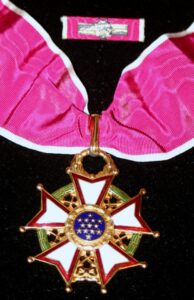
Frank didn’t find high-dollar military memorabilia like this– but he put a lot of history back in circulation.
One key to success for us and our clients? We don’t have to be experts in every antique and collectible in the world. We just have to know who to call.
Enter Tim Frank, owner of Mid-Atlantic Military Antiques. He shares our land ethic and passion for preservation. Frank works hard to put historical items back in circulation even when there aren’t military antiques like generals’ pistols and military medals for him to resell to his history-loving collector buyers. He sorted through the tubs of military objects and memorabilia we set aside for him and made a fair offer to the client. Frank also spent considerable pro bono time in the weeks ahead sorting through all of the miscellaneous military papers. Many were at least worth donating to various archives for future historians to use.
2. Donate household items to various nonprofit organizations.
We pulled out a moving truck full of items that were good enough and clean enough to take a number of charities. This is always a key component of how to liquidate an estate the right way.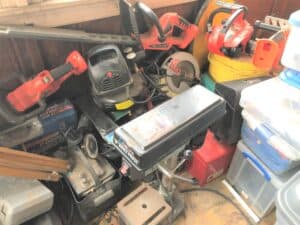
Our team filled clear, industrial-sized trash bags with clothing for the nearest Goodwill donation center. We sent a van load full of basic tools (hand tools, power tools, etc.) to Community Forklift on our clients’ behalf. As always, we provide the client with a formal letter detailing the donations and suggested donation values. This provides them with the proper documentation they and their accountants love.
Our crew also leaned on years of experience by placing items not clean or perfect enough to donate in the front yard with a “Take Me!” sign. A lot of people are willing to clean dingy clothes to use for themselves or to donate once they’re fresh. Other folks happen to know other people who can use or repair things, so they take those for us. We’re grateful to everyone we meet who share our values.
3. Recycle everything possible.
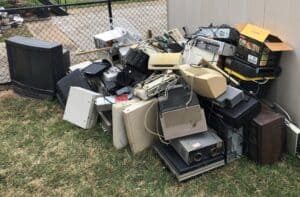 Hoarders naturally acquire tons (sometimes literally) of objects that can’t be sold, donated, or otherwise given away. Day after day, our team hauled pound after pound of these materials out of the house. We organized them into mounds in the backyard. One for broken electronics. Another for scrap metal. One section for paper and cardboard. Yet another for plastic.
Hoarders naturally acquire tons (sometimes literally) of objects that can’t be sold, donated, or otherwise given away. Day after day, our team hauled pound after pound of these materials out of the house. We organized them into mounds in the backyard. One for broken electronics. Another for scrap metal. One section for paper and cardboard. Yet another for plastic.
We normally take these items to the nearest municipal landfill/transfer station ourselves. The volume here, though, was more than we had time to handle by our deadline.
Bring in another trusted company to help with trash overload
I called Kevin Wheeler at 123Junk. Orion’s Attic has tremendous respect for his kindred spirit company because of the work it does to recycle and reuse objects.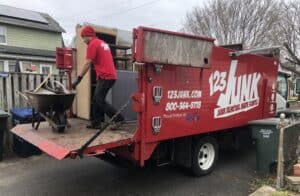
We partner with 123Junk on jobs in which we need extra muscle and extra trucks. We also send business its way when potential clients call us who don’t need our value-added services of liquidating estates and buying antiques and collectibles.
Wheeler put us on his schedule right away and sent multiple trucks to retrieve the recyclable materials we prepared. His team recycled it all and hauled away additional trash. (123Junk, like us, is also a member of the Washington Metro Chapter of the National Association of Productivity and Organizing Professionals’ Business Partner program. We turn to fellow members to help our clients with all kinds of “stuff”-related tasks, from trash-hauling to digitalizing photos.)
4. Upcycle an abandoned boat to save it from a landfill.
Abandoned boats and other derelict vessels are becoming a huge problem across the Chesapeake Bay region and throughout the country. Orion’s Attic solved multiple problems at once by bringing a deteriorating fiberglass boat home with us. We gave it lots of tender loving care and turned it into a milkweed-packed monarch butterfly garden. This saved the client money in disposal fees and did good for Mother Nature.
5. Turn up items of great sentimental value.
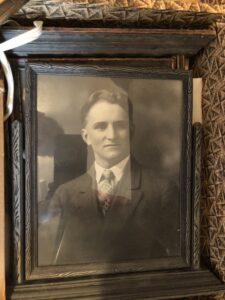 Clients are often more concerned about finding items of great sentimental value than they are items worth actual money. We’d be hard-pressed to believe there are estate liquidation company owners who are more sentimental people than we are. We have a keen sense of recognizing sentimental items, even those buried by mountains of trash.
Clients are often more concerned about finding items of great sentimental value than they are items worth actual money. We’d be hard-pressed to believe there are estate liquidation company owners who are more sentimental people than we are. We have a keen sense of recognizing sentimental items, even those buried by mountains of trash.
It’s relatively rare for us to tackle even a spotless Potomac mansion in which we don’t locate sentimental treasures that clients lost. It’s just as common for us to find things they didn’t even know existed. We’ve had clients and family members alike collapse into tears when we turn up anything from childhood mementos to wedding documents hand-signed by great-grandparents.
This house was no exception. We set those items aside and waited for the client to advise us on whether she wanted us to save them for her.
6. Clear the hoarder house of all remaining objects and leave it broom-clean.

The basement presented the greatest challenge at this house. It had apparently flooded long ago and remained a swamp. The real estate agent said the reason that neither the electricity nor the plumbing in the house worked was that no service provider would enter the basement.
In a scene befitting the Shawshank Redemption scene of Andy Dufresne crawling through the sewer tunnels outside the prison, we made our way through. We rescued what was on high ground and waded into the rest to pull that out.
All objects removed, we cleaned the house as best we could and made way for the remodeling contractors to take over.
The end result of the hoarder house estate liquidation and cleanout? Good for the client, good for Earth.
 This job was a backbreaker but it was deeply rewarding. The kind of job that left us exhausted but extremely proud of the work we accomplished. The kind that powers our desire to keep taking on these big, bruising projects.
This job was a backbreaker but it was deeply rewarding. The kind of job that left us exhausted but extremely proud of the work we accomplished. The kind that powers our desire to keep taking on these big, bruising projects.
We never got to meet the homeowner because she lived out of state — but she became a hero to us. She could have opted for potentially cheaper options for dealing with the house, including selling it as-is.
But she didn’t.
It was important to her to do the right thing for all the items in the home and for the planet.
The news gets even greener.
The real estate agent later told us the house sold quickly, putting enough money in her client’s bank account to last her the rest of her life.
The beat-up old painting we found? It sold at auction for more than $5,000! The rest of the various sales produced solid numbers, too. The net result in dollars and cents? Hiring Orion’s Attic ultimately proved to cost about as much or less than what other service providers quoted.
Want to learn more about how to liquidate an estate the right way?
Contact us today! Orion’s Attic is a full-service estate liquidation, downsizing, and home cleanout company based in Silver Spring, Maryland. We also buy antiques and collectibles. We serve Montgomery County and the entire metro Washington D.C. area (D.C., Maryland, Virginia).
Learn more about liquidating estates in our Estate Liquidation and Downsizing Guide.
Learn more about selling all kinds of collectibles including vintage toys in Sell Us Your Stuff.
Find out more about why we’re the environmentally responsible choice for your estate liquidation in Green Choice.
See how we handle what has become a calling for us in Hoarding.


